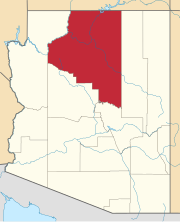Leupp, Arizona
In 1942 the facility was converted for use as the Leupp Isolation Center, designed to detain Japanese and Japanese-American internees from the several larger internment camps established by the War Relocation Authority to hold citizens and immigrants from the West Coast.
In 1929 Stanton K. Borum and his wife Ida Mae became owners of the Leupp Trading Post.
After William and Lucile retired in 1968, their son, Ralph, and his wife, Ellen, took over the business, running the Leupp Trading Post until 1982.
Germans were known to have sent people to the US in the postwar period to learn these languages before World War II broke out, so the US did not repeat using code talkers from these tribes in Europe.
Philip Johnston was a European American who had grown up in the Leupp area with his missionary parents, where he learned some Navajo.
As an engineer in World War II, he suggested to the Marines to use the Navajo language as a code against the Japanese.
He knew how impenetrable and complex the language was, making it nearly impossible for an outsider to learn easily.
The Navajo language is so complex with its dialect and sentence structure that it would take code talkers 2+1⁄2 minutes to successfully translate and transmit and then re-translate the message.
The 16 men suspected as having instigated the protests were removed from camp and placed in surrounding town jails.
While they were held in jail (without being charged with a crime or allowed a hearing), War Relocation Authority officials converted a former Civilian Conservation Corps camp outside Moab, Utah, into a temporary isolation center for "noncompliant" Japanese Americans.
Over the next three months, another 25 "troublemakers"—mostly men who had resisted the WRA's attempts to assess the loyalty of incarcerated Japanese Americans by asking them to take a poorly worded oath—were brought to Moab.
(Five men, serving sentences in the nearby county jail after protesting conditions in the isolation center, were transported to Leupp in a five-by-six-foot box on the back of a truck.
Their separate transportation was arranged by Moab director Francis Frederick, who had also sentenced them for "unlawful assembly.
Leupp housed a population of approximately 50–60 prisoners at a time, with a total of 80 Japanese Americans passing through the isolation center while it operated.
The 52 inmates then residing in Leupp were transferred to the stockade at Tule Lake (converted to a segregation center for "disloyal" Japanese Americans earlier that year) on December 2, 1943.
According to Mitch Strohmann, the public relations official at FUSD, this school, in 2002, had "made some amazing strides in recent years.
The Navajo Nation manages and operates it under contract to the Bureau of Indian Education (BIE), which funds it.


